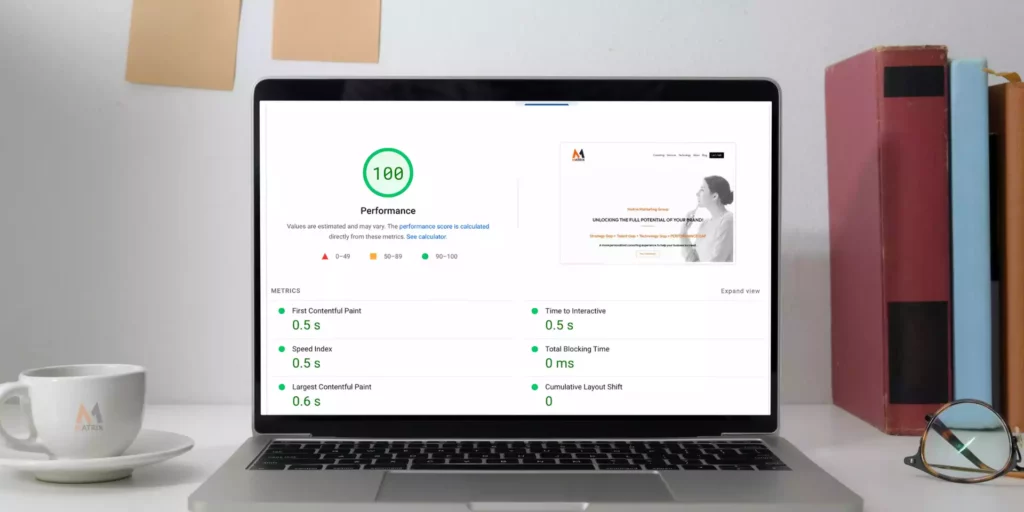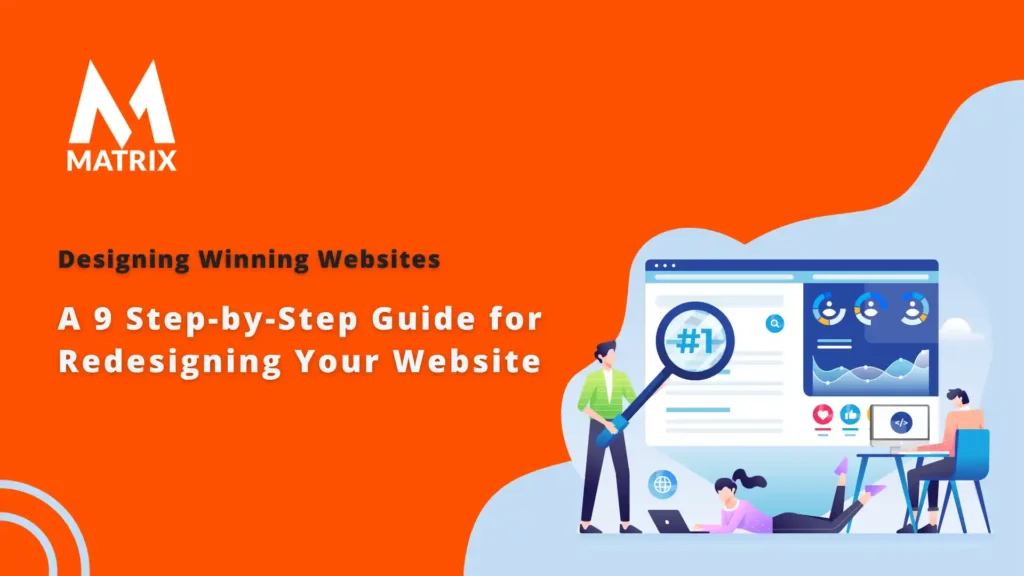A 9 Step-by-Step Guide for Redesigning Your Website
The Ultimate Guide to Building a Website Redesign Strategy: A 9 Step-by-Step Guide for Redesigning Your Website
Are you looking to give your website a facelift? Although redesigning your website can be intimidating, the process doesn’t have to be overwhelming.
With the right steps, you can create a beautiful and functional site that fits perfectly with your brand and helps you reach more customers. We have included some website redesign examples as well.
This blog post will guide you in properly redesigning your website, from finding inspiration to choosing the right platform, creating wireframes, and more. Read on for our comprehensive how-to guide on website redesign!
Are you looking to give your website a makeover? We can help! Our experienced web designers and developers create stunning, user-friendly websites that look great on all devices. Let us help you make your website stand out from the competition. Get in touch today to discuss your project needs. We can’t wait to work with you!
We understand how important it is for businesses to have a strong online presence. That’s why we use the latest web technologies to create beautiful, interactive websites that look great on all devices and keep visitors engaged. Our team of professionals will work with you every step of the way to ensure that your website meets your exact needs and specifications.
Our web design process is tailored to each project so that we can deliver the best possible results for your business. We’ll start by getting to know you and understanding your website’s goals. Then, we’ll create an engaging design that puts your brand front and center. We use intuitive navigation and responsive layouts so visitors can easily find what they want on any device. Finally, we ensure all the most important information is accessible anywhere on your site.
Our team is passionate about providing an intuitive user experience optimized for search engine optimization (SEO). We create websites that are easy to update and maintain so you can stay ahead of the ever-changing digital marketing landscape. Plus, we provide ongoing support services to ensure your website runs smoothly and looks great all year round. Whether it’s refreshing content, adding new features, or ensuring your site is always updated with the latest technology, we are here to help.
At Matrix Marketing Group, we aim to provide a website that meets all your business needs and drives real results. We understand the importance of an attractive website that appeals to current and potential customers.
Your Blueprint for SEO Success in 2025
Whether you’re a business owner, marketer, or seasoned SEO professional, this guide is tailored to give you a competitive edge in the evolving digital landscape. Get SEO Pricing.
Redesigning your website doesn’t have to be overwhelming. Our comprehensive how-to guide on website redesign will provide a step-by-step process to revamp the content & structure of your website so it looks attractive, fits with your brand, and is easy to navigate.
With our updated guide, you can boost performance and convert more visitors by properly designing and structuring your site. You’ll learn how to find inspiration for design ideas, choose the right platform for hosting, create wireframes that work best for you, and much more!
Please read our blog post for an in-depth look at how to redesign your website successfully!
How often should you redesign your website?

Redesigning your website is an important part of maintaining a successful online presence. Deciding how often to redesign your site depends on various factors, including the type of website you have, the content it contains, how quickly technology changes, and how often you change content or features.
For most businesses, a website redesign should happen every one to two years. Technological advancements and changing consumer preferences mean that content must be updated regularly to stay relevant. Additionally, websites must be updated with the latest security protocols to protect user information.
If your website is for ecommerce purposes or has a lot of user interaction, more frequent updates may be necessary. Ecommerce sites should ensure their checkout process remains intuitive and user-friendly as new payment technologies emerge and shoppers’ expectations evolve. Additionally, user interaction websites should ensure that their navigation functions properly on all devices and that their forms are optimized for conversion rates.
Affordable SEO Solutions That Drive Real Results
Matrix Marketing Group Delivers Customized SEO Strategies with Transparent Pricing for Maximum ROI. See SEO Services.
Content-based websites may also require more frequent updates to keep visitors engaged. If your website offers educational material or news reporting, its content should be timely and relevant to maintain engagement levels. Content that is out-of-date or irrelevant can significantly decrease visits over time and limit the effectiveness of any other measures taken to optimize the site’s performance.
A website redesign can also benefit businesses looking to launch new products or services or rebrand themselves completely. This requires much more frequent updates than a simple maintenance overhaul, which involves changing design elements such as colors and fonts and updating vital back-end components like the coding languages used on the site and the server hosting options chosen.
Businesses of any size or industry sector need to monitor their website regularly to identify when they need an update or comprehensive redesign to stay competitive online.
The optimal frequency of doing this will depend on individual business objectives. Still, generally speaking, it’s best practice not to wait too long between major overhauls so that your site always looks modern, functions well across all devices, and can meet customer needs both now and into the future!
What is a website redesign?

Website redesign is changing a website to improve its look, feel, and functionality. This includes modifications to the layout, design elements, content, features, navigation structure, and back-end components.
Redesigning a website allows businesses to improve their online presence and increase user engagement. This website redesign example shows speed matters.
Top 7 reasons when and why you should redesign your website
Website redesign is important for businesses to keep up with industry trends and customer expectations. Here are the top seven reasons why you should consider redesigning your website:
1. Improve User Experience: Redesigning your website can improve user experience and increase engagement, allowing customers to easily find what they’re looking for. A redesign allows you to add drop-down menus and animated elements that help visitors easily navigate the site. Making the interface easier to use increases the likelihood of people spending more time on your website. How to redesign a website UX is an art.
2. Stay Relevant: Technological advancements and changing consumer preferences mean content must be updated regularly and kept fresh to stay relevant in customers’ minds. With a redesign, you can ensure your website is up-to-date with current best practices and industry standards so users have a positive experience every time they visit.
3. Increase SEO Performance: SEO performance is closely tied to website design, and changes could significantly improve rankings on search engine result pages (SERPs). Optimizing titles and meta tags, rewriting copy, cutting down page load times, optimizing images, or linking internal pages together better than before can dramatically improve your SEO performance with a successful website redesign.
4. Modernize Your Brand: Regarding web design trends, styles can change drastically within a few years. By staying ahead of these trends through regular updates and improvements, you ensure that customers remain interested in your brand for longer without completely reinventing it from scratch every few years.
Only 26% of Marketing Budgets Directly Impact Sales Revenue
26% of marketing budgets are allocated to activities that have a measurable and direct impact on sales revenue. The remaining budget is often spent on brand awareness and other intangible efforts, leaving significant room for optimization in aligning spend with ROI-driving activities. (Gartner)
5. Keep Up With Changing Technology: If your website was built using outdated technology or languages such as HTML5 or Flash Player, chances are that it won’t work correctly anymore because new browsers won’t recognize it! Using more modern languages such as JavaScript or PHP can offer faster loading times, creating a smoother user experience—something all potential customers will appreciate!
6. Address UX Issues & Security Risks: One major reason websites need to be redesigned periodically is that user experience issues may start occurring due to old technology being used on the site itself. This could range from navigation problems caused by outdated coding techniques to security risks resulting from an unpatched system vulnerability in an outdated component of the site framework itself! Redesigning ensures these issues are addressed quickly before any real damage is done!
7. Make Room For Growth & Expansion: As businesses grow, their needs change, including websites, too! Redesigning allows businesses to plan for expansion beforehand so their sites can handle more traffic without issue while making room for future growth! This way, businesses don’t need to worry about constantly updating their sites whenever something new needs to be added!
9 Steps for planning a website redesign

With website redesign becoming increasingly important for businesses to stay relevant and competitive, it’s important to understand the steps involved in properly planning a website redesign. Here is a step-by-step guide on how to plan your website redesign:
1. Identify Your Goals: It is important to identify and set goals before redesigning your website. Ask yourself questions such as, “What are the primary objectives of this redesign? What features do I need? How can I measure success?” Establishing clear goals will guide your entire redesign effort and ensure it yields the desired results.
2. Gather Inspiration: Getting inspired by looking at other websites is important before creating wireframes or hiring a designer. Research and look for examples of trends in web design and sites from your competitors and industry verticals with similar objectives. This will give you ideas on how to best approach the redesign process. Audit Current Website: Before redesigning, look at your current website. What are its strengths and weaknesses? What can be improved upon? While it’s tempting to “start from scratch,” many of the elements on your current website may still have value and should be considered as you plan out your new design.
3. Research & Analyze: Before starting your website redesign journey, it’s important to research current trends in web design and user experience. You should also review analytics data from your existing website, and industry benchmarks to gain insight into visitor behavior and identify areas needing improvement or optimization. Research and planning are started once you’ve identified and audited your current website. It’s time to start researching and planning for your website redesign. This involves looking into what other websites are doing, studying best practices, and developing a plan for how the new site should be structured. How to Choose the Right AI Digital Marketing Agency: A Comprehensive Guide for Marketing Managers
4. Prioritize & Plan: Once you’ve outlined your goals, researched current trends, and analyzed analytics data, it’s time to prioritize tasks based on their most-to-least importance according to your business’s objectives. Create a detailed plan outlining who will be responsible for each step of the design process and their expected timeline for completing each task.
5. Identify Resources & Budget: Having a solid understanding of which resources you need before beginning any project is essential for success. This includes budgeting for human resources (e.g., designers) and technical requirements such as hosting or coding services required for the implementation of the new design elements. Ensure these are considered when creating your roadmap so that budgeting doesn’t become an issue down the line!
6. Choose the Right Platform: Once you’ve gathered some inspiration, it’s time to choose the right platform for your website redesign. Depending on the size and scope of your project, you can decide whether to build a new site from scratch or use an existing platform such as WordPress or Magento.
7. Create Wireframes & Mockups: Sketch rough wireframes and mockups for each site page before you start the actual design process. This will help you create a visual outline of how your website should look and work. It will also help designers better understand their expectations, resulting in more accurate results.
8. Test, Test, & Test Some More: Once the design is complete and the website is live, it’s important to test the different features thoroughly to ensure everything functions as intended. It’s also important to perform usability tests with real people to get feedback on how they interact with your site. Testing can be time-consuming but will ensure your website performs as expected.
9. Monitor & Adjust: Once your new website has launched, monitor its performance regularly to ensure that it meets all the goals and objectives outlined in the roadmap initially created during the project’s planning stages. If not, make adjustments accordingly whenever necessary! Additionally, don’t forget to keep up with industry trends so that your site remains relevant over time!
Redesigning a website can be daunting, but following the steps in this guide will help ensure you get it right and create an engaging and user-friendly experience for your visitors. With the right planning and preparation, you’ll be well on your way to creating a website that looks great, works well, and helps you reach your business goals.
Having a strategy and roadmap is essential for success in website redesign. A good strategy and roadmap can ensure that your redesign project is completed promptly, within budget, and with the desired results.
Organizing a plan before embarking on any website redesign project is key to success. Understanding current trends and analyzing existing data helps inform decisions regarding which tasks should take priority over others while also helping avoid costly mistakes later on in the process!
Following these steps should ensure that all aspects of your site are optimized properly while staying within budget requirements, ultimately resulting in higher ROI from visitors engaging with your revised website! AI vs. Human Content: Navigating the Future of Storytelling
Website redesign pitfalls to avoid
A website redesign can be a complex and time-consuming process. Understanding the pitfalls is essential to ensure your website redesign project goes as smoothly as possible. Here are some of the most common website redesign pitfalls to avoid:
1. Not Knowing the Goals: Before you begin, it’s essential to clearly understand the desired outcomes of your website redesign. Without a set goal, you will likely go down rabbit holes and waste time on unnecessary tasks that don’t contribute to achieving your desired outcome. A good way to start is by creating an initial roadmap outlining what needs to be done, when, and by whom.
2. Poor Audience Research & Analysis: Before beginning the redesign process, it’s important to understand your target audience, their needs and wants, what they do online, and how they interact with websites generally. Creating an effective design that caters to their needs or desires without this data won’t be easy.
3. Failing To Test Your Site: Testing should be integral to any website design process. You should test for functionality (ensuring all features work as expected) and usability (checking for user experience). Testing also helps identify potential issues before launch so they can be addressed before it goes live!
4. Selecting the Wrong Platform: When choosing the platform for your website redesign project, it’s important to select one that suits your specific requirements in terms of scalability and flexibility rather than just focusing on its popularity or aesthetics. Even if a platform looks great on the surface but isn’t suitable for future growth or feature upgrades, you could end up wasting both time and money in the long run!
5. Poor Communication Between Stakeholders: Website projects often involve multiple stakeholders, such as designers, developers, and content writers. Communication between these teams should be clear from the start. Hence, everyone understands their roles and expectations throughout the entire process! Keeping everyone aligned with regular meetings helps ensure all tasks are completed on time with minimal issues occurring during the implementation stage!
6. Ignoring SEO & Accessibility Issues: Search engine optimization (SEO) should always be considered when designing a new website – optimization content & structure of your site helps ensure better visibility in search engine rankings, ultimately leading to more organic traffic from Google & other search engines! Additionally, accessibility issues such as ensuring images include descriptive alt tags are also essential for ensuring users with disabilities can access & use your site easily!
7. Not Having Mobile Optimized Design: With mobile usage surpassing desktop usage worldwide now more than ever, any website redesign must consider how it looks on various devices such as tablets and smartphones to optimize user experience across all platforms! This includes size adjustments for buttons and images as well as ensuring all text is legible across different screen sizes, etc.
To ensure success in your next website redesign project, plan while avoiding these common pitfalls! Considering user research & understanding SEO best practices before starting can help reduce potential headaches while helping guarantee a successful result!
How to choose the right website redesign agency or services
Key factors must be considered to ensure success when choosing the right website redesign agency or services. It is important to take the time to evaluate each potential provider’s qualifications, track record, and pricing structure to make an informed decision regarding which company is the best fit for your needs.
Matrix Marketing Group’s website redesign services are world-class. Since 2002, we have redesigned over 1400 websites. By leveraging an AI-driven digital marketing agency, your content will be better, and your cost will be much more affordable.
The first step when evaluating website redesign agencies or services is to assess their experience and expertise in creating and optimizing websites for desired outcomes. This means looking at case studies of previous projects they have completed and any awards or recognition they may have received from industry peers.
It can be beneficial to inquire about any certifications or accreditations they may hold, such as Google Adwords certification, that shows the agency has met specific standards related to online advertising campaigns.
It is also important to review portfolio samples to understand the provider’s style and type of work. Pay special attention to aesthetic design and technical aspects such as usability, responsiveness, page load speed, etc. – all these elements should be considered when selecting a website redesign provider.
Another factor worth considering is customer testimonials and reviews – these provide invaluable insight into what working with a particular agency is like and whether or not they are reliable and meet deadlines on time. Be sure to check out third-party reviews on other sites, such as Google My Business or Clutch, and those on the agency’s site if available.
Finally, pricing should also be considered when selecting a website redesign service provider. While cost should not be the sole driver of your decision-making process, the budget should still factor in since businesses often fail due to financial mismanagement and lack of understanding of costs associated with digital marketing campaigns.
When requesting quotes from different providers, ensure you know what is included in the package (number of pages created/updated/revamped) and any ongoing maintenance fees that might apply after launch so that your site’s performance continues uninterruptedly.
Considering all these points before committing yourself—and your budget—to a particular web design project will help ensure that you choose the right agency or service provider to deliver a successful outcome tailored specifically to your business goals!
We can send you a website redesign project plan pdf or a website redesign project plan template.
Shifting from Lead Generation to Revenue Generation: A New Era for Marketing Managers
Unlocking 67% More Revenue: The Shift Every Marketing Manager Needs to Make
In today’s fast-paced digital landscape, marketing managers are bombarded with new strategies and tools claiming to revolutionize their approach. This statistic is not just a number—it’s a call to action for marketing leaders to reevaluate their strategies and realign their efforts with the bottom line. Schedule an appointment.
General FAQs
What is the website redesign price?

Website redesign prices can vary depending on the project’s scope, the design’s complexity, and the services provided. Generally, website redesign prices start at around $2,000 but can exceed $20,000 for more complex projects with additional features. Prices will typically include web design and development services such as creating responsive wireframes and user interfaces (UI/UX), coding pages in HTML/CSS/JavaScript, and integrating various plugins to extend functionality.
What does it cost to redesign a website?

The cost of website redesign varies depending on the scope and complexity of the project. Generally, website redesign prices start at around $10,000 but can exceed $20,000 for more complex projects with additional features. Prices may also include web design and development services such as creating responsive wireframes and user interfaces (UI/UX), coding pages in HTML/CSS/JavaScript, and integrating various plugins to extend functionality.
What is the cost per page to redesign a website?

The cost per page to redesign a website can vary depending on the complexity of the design, services provided, and other factors. Generally speaking, you should expect to spend around $500-$2000 per page for a standard website redesign, with additional expenses in some cases for custom features or third-party add-ons.
How long does it take to redesign a website?

It can take anywhere from several weeks to several months to completely redesign a website. Any project’s timeframe will depend on the complexity of the design, services provided, and other factors. In many cases, web design & developing processes are broken down into multiple stages, such as creativity/inspiration gathering, wireframing & prototyping, coding pages in HTML/CSS/JavaScript, and integrating various plugins to extend functionality. A typical 15-page website from start to finish can take up to 12 weeks. But we’ve accelerated that process with agile, rapid design.



